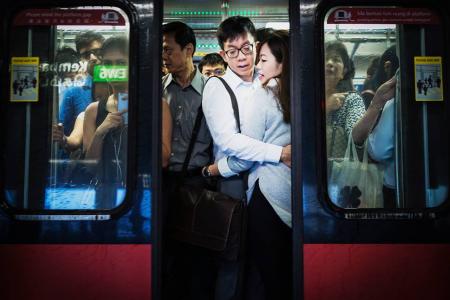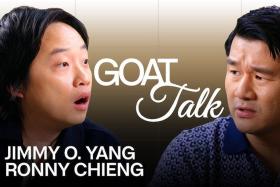Faces on the MRT: S'pore photographer snaps expressions of peak hour commuters
When taking the MRT train to work, one is probably too pre-occupied with one's own frustrations to notice what other commuters are doing (or feeling).
But photographer Edwin Koo has managed to capture these moments, providing an insight into how traveling on the MRT can be like for the thousands that have to deal with the peak hour crush.
His photos, which he first uploaded on Facebook last Thursday (April 2), have been compiled into a book, Transit, which will be launched April 7.

Mr Koo said that since the photo album was uploaded, about 12 people have come forward asking for the prints of the photos they were featured in.
"I may have made some commuters uncomfortable, especially since I was unable to communicate to you the nature of this project," wrote Mr Koo in his Facebook post.
"So now is the time for redemption" he said, adding that he wanted a chance to get to know these people in real life.
The New Paper spoke to Mr Koo, whose photos have been shared widely this past week on social media.
Q: When did you start taking these photos?
Mr Koo: In 2011, I had returned to Singapore after living in Nepal for 2 years. When I saw how crowded Singapore’s MRT trains have become, I started to photograph the situation out of a sense of frustration and alienation. I was protesting against the system. When my anger died down, I realised that there are interesting things I could observe from the frozen moments at the train doors.
Each scene presented a glimpse into the Singapore we live in today.

Q: What has the reaction to your photos been like?
Mr Koo: It has been surprisingly encouraging. Many strangers have shared the album called “The People of Transit” with their friends, just to help me locate the people in the photos. Many of them also sent words of encouragement.
Of course, there were people who raised the issue of privacy. My intention was never to intrude on the privacy of any individual, but to paint a collective portrait of the commuters in Singapore. I had removed two photos from the FB album and also on my official website at the request of the subjects, out of respect for those who do not wish to be part of Transit.
Overall, I am pleasantly surprised that Singapore has become a rather mature and tolerant society - one that can raise a mirror to itself and laugh at our own plight and shortcomings.
Q: Have commuters chided you for taking their photos?

Mr Koo: I did get my fair share of death stares. Honestly, it doesn’t feel good to get death stares, but I accept that this is part of the artistic process of creating a candid and honest body of work.
Q: Do you intend to move on to buses too?
Mr Koo: I won’t rule it out. Ultimately, they are both metal containers that pack in an incredible number of commuters during the peak hours. Transit is also a study of how people feel and behave when packed into a very small space, so buses qualify too. But the execution needs careful planning and understanding of bus routes and commuter behaviour.
Q: What have you learnt after this project?
Mr Koo: I can draw two broad conclusions. First, contrary to popular perception, our mass rapid transit has improved tremendously over the last 4 years. In 2011, waiting times were longer and trains were generally more crowded. Now, the trains come more frequently, and the platforms clear quickly even in peak hours. I think the issue is really a sudden increase in our population that made it hard for public transport to cope.
Second, small gestures of kindness can make a huge difference to someone else’s day.
On some days, after getting too many negative reactions, and missed moments, I feel totally battered. But then along comes a smile or peace sign from a random commuter and that really makes my day, even if it doesn’t make a photo.

PHOTOS: Transit
Get The New Paper on your phone with the free TNP app. Download from the Apple App Store or Google Play Store now


